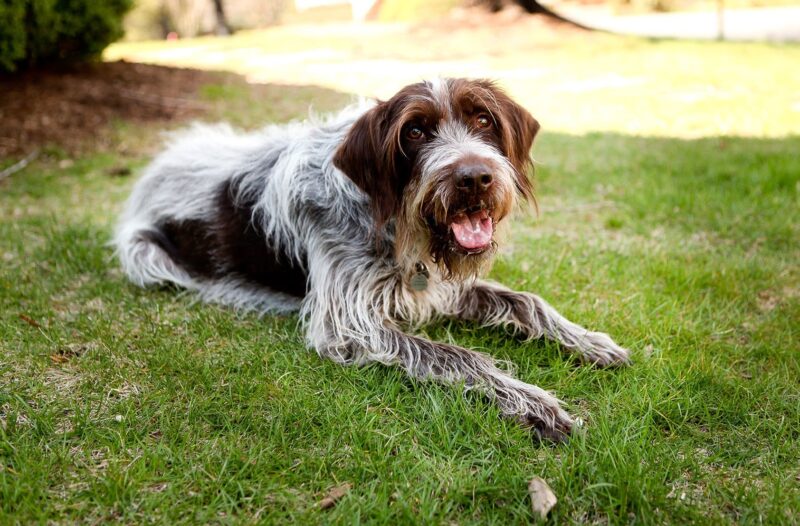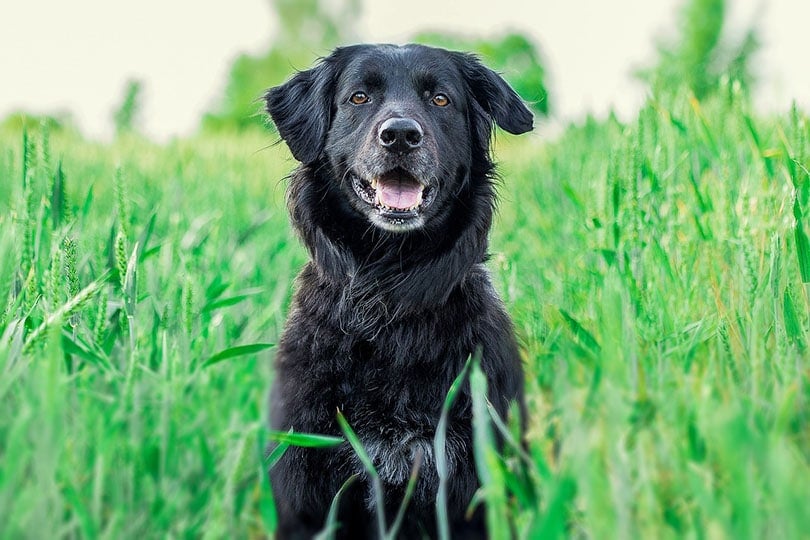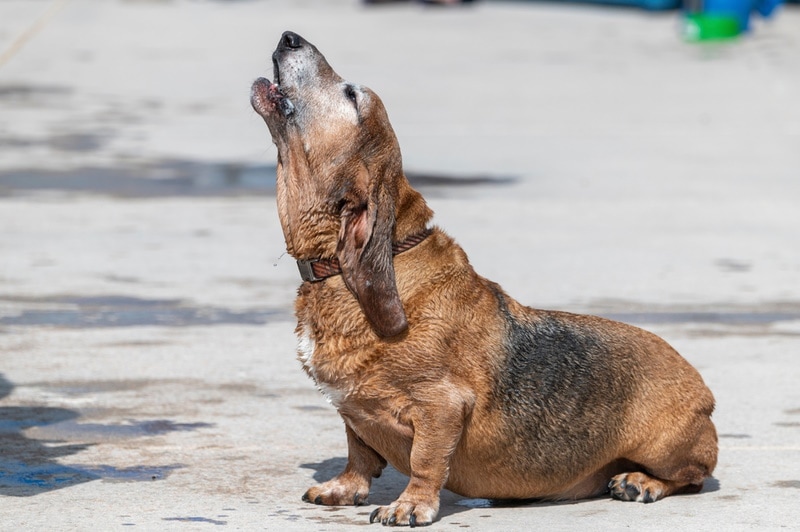Komondor Great Pyrenees Mix: Pictures, Care Guide, Temperament & Traits
Updated on
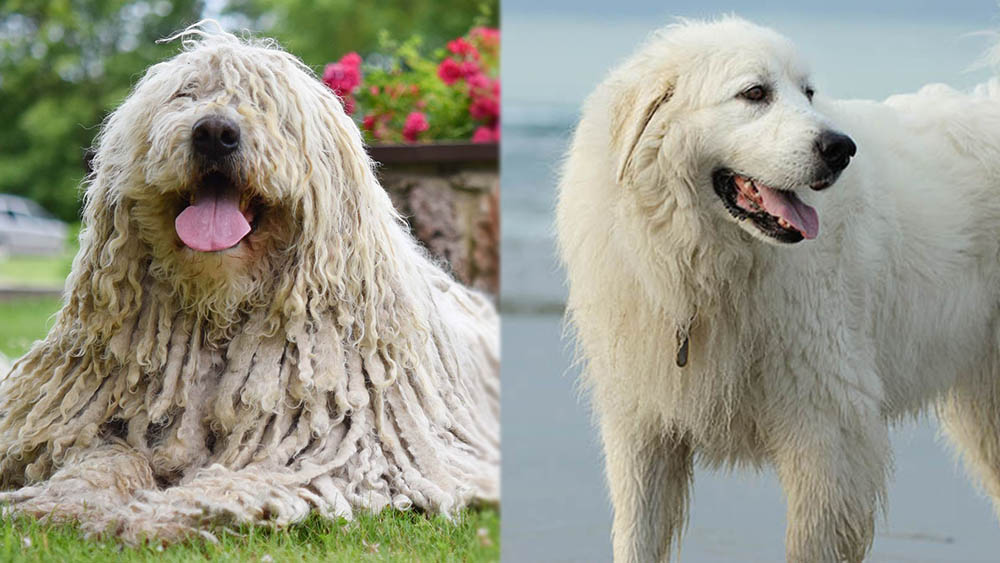
Click to Skip Ahead
The Komondor Great Pyrenees mix is a hybrid of two livestock-guarding breeds: the Komondor and the Great Pyrenees. These dogs are gentle giants known for their loyalty, affection, and protectiveness toward family. They are extremely powerful but difficult to train, thanks to their independent and stubborn temperament; however, their companionship is unlike anything else.
If you’re considering adopting a Komondor Pyrenees mix, there are some things you need to know. Read on to learn more about both parent breeds and learn if you’ll be up to the task of raising one of these amazing but challenging dogs.
| Height: | 25.5–32 inches |
| Weight: | 70–110+ pounds |
| Lifespan: | 10–12 years |
| Colors: | White, gray, tan, badger, reddish-brown |
| Suitable for: | Experienced dog owners |
| Temperament: | Affectionate, loyal, stubborn, protective |
The Komondor Pyrenees Mix is a hybrid of the steady and independent Komondor and the fearless and strong-willed Great Pyrenees. The mix combines both parent breeds’ best (and worst) traits, including their loyalty and loving nature and their stubborn and strong-willed temperament.
The appearance of this hybrid can vary depending on which parent breed the individual pup takes after. The Komondor, sometimes known as the Hungarian Sheepdog, is a livestock guardian breed easily recognizable thanks to its long, corded coat. The Pyr coat is fluffy and weatherproof thanks to its history as a livestock guardian for the farmers in the European Pyrenees Mountains.
Komondor Great Pyrenees Characteristics
Komondor Great Pyrenees Mix Puppies
The Komondor Pyrenees mix is one of the most common, though finding a breeder can be challenging. You might have better luck scouring Petfinder or your local rescue’s website to find an adoptable puppy looking for his forever home.
The Komondor is a fairly rare breed, nearly wiped out during World War II, with only a few dozen individual dogs remaining after the war. Though it was slowly re-established in Hungary after the fact, it still remains that this is a breed most people have never seen. It is estimated that their population is less than 10,000.
The Komondor Pyrenees puppy is intelligent and affectionate; however, this mix’s independent and stubborn nature can begin to come out from a very young age. You must begin training your puppy as soon as you bring him home to ensure he grows to look at you as the alpha and doesn’t assume that role himself.
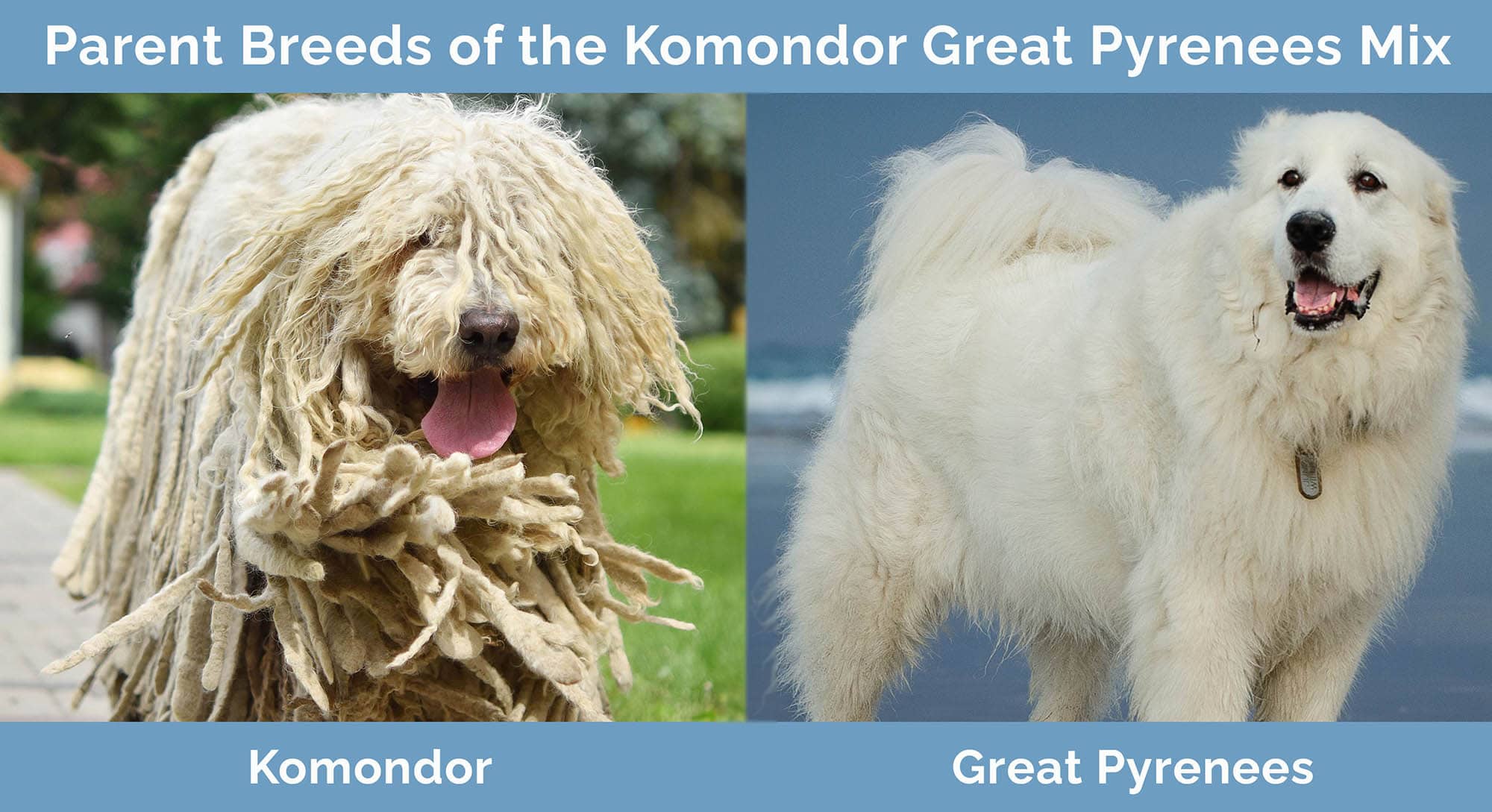
Temperament & Intelligence of the Komondor Great Pyrenees Mix
The Komondor Pyrenees can be a calm, subdued, and placid pet. They’re highly loyal, protective, and affectionate toward their family members, though they sometimes have a streak of domineering and stubborn behavior. They love being with their family, but they also value alone time and require a space in your home where they can retreat.
Both parent breeds have a background as being the chief protector of herds, so the Komondor Pyrenees is sometimes wary of strangers and is known to be fiercely protective. All potential owners should be ready and willing to put their dogs into training as soon as possible to ensure a well-rounded and well-behaved adult dog.
Are These Dogs Good for Families? 👪
The Komondor Pyrenees mix can make a fantastic companion for families with children. They may, however, struggle to accept strangers. This breed will readily engage in playtime with the kids, and you’ll love watching them showcase their infinite energy and enthusiasm. The best part about these dogs is that since they’re so protective and loyal, they’ll seamlessly transition from happy-go-lucky, energetic dogs into loving and gentle cuddle buddies.
It is important to note that your dog may misinterpret rough play as aggression, so it’s best to keep a close eye on your children during playtime.
Remember, this hybrid breed can weigh more than 100 pounds, so if you have small children in the home, it may be best to wait until they’re older to adopt one.
Does This Breed Get Along With Other Pets? 🐶 😽
The Komondor Pyrenees mix can get along well with other dogs and household pets. However, it largely depends on your pup’s personality and which parent breed he takes after more.
Komondors are less likely to get along with cats and can sometimes be aggressive toward other dogs. Their strong guarding instincts can make them suspicious and dominant toward new and strange dogs.
You can increase your chance of successful integration by ensuring your dog receives proper training and socialization from the get-go. Still, we don’t recommend having your heart set on a house full of animals if you have a Komondor Pyrenees mix in the home.
Things to Know When Owning a Komondor Great Pyrenees Mix
Food & Diet Requirements 🦴
Selecting the right diet mix will come down to the needs of your individual pup. While choosing a diet consisting of the highest quality ingredients is important, we always recommend keeping an open line of communication with your veterinarian, as they can provide useful suggestions based on your dog’s life stage and medical history.
Generally speaking, this hybrid will need a diet designed specifically for large breeds in whatever life stage he is currently in.
Because this is a large, deep-chested breed, he may be at risk of gastric dilatation and volvulus or bloat. To lower your pup’s chance of developing this life-threatening condition, feed him multiple smaller meals throughout the day and avoid planning exercise around meal times.
Exercise 🐕
Pyrs are immensely powerful working dogs, bred to deter predators from stealing sheep on the snowy mountaintops of the Pyrenees Mountains in Europe. Komondors are fast, powerful, and unafraid to leap at predators to drive them away. Like the Great Pyrenees, Komondors were also used to guard sheep. You can expect your hybrid dog to be an athletic and agile pet, requiring sufficient exercise to stay happy and healthy.
The Komondor Pyrenees will require 60 minutes of exercise daily. A few walks a day should be more than enough.
Training 🎾
The Komondor Pyrenees can be difficult to train as he’ll be naturally willful and independent. He will require a firm and experienced hand in training, so this is not a dog suitable for first-time dog owners.
However, because of its power and size, you must begin training your dog as soon as possible. An improperly trained Komondor Pyrenees can be challenging to control and extremely stubborn. It would be best to establish yourself as the pack leader as soon as possible.
The best training for such a dog is fun and varied to keep your pup interested. Your priority should be on socialization with other animals and strangers, good leash behavior, and emergency recall.
Grooming ✂️
The grooming requirements of your Komondor Pyrenees mix will depend entirely on what parent breed your dog takes after more.
The Komondor is known for its beautiful corded coat weighing as much as 15 pounds! Their double coat consists of a woolly and thick overcoat and wiry undercoat. As your pup grows, the two coats fuse into one another, creating those trademark cords. The coat doesn’t need to be brushed, but the cords should be regularly separated to prevent matting. Komondor owners should be prepared to regularly trim the cords to keep them clean and manageable. Unfortunately, the ropes collect debris very easily, so regular baths are vital in keeping your dog and home clean. Drying can take as long as two and a half days to complete.
The Great Pyrenees also has a double coat, though their undercoat is much softer than the Komondors. Their silky outer coat is easy to manage as it is somewhat resistant to both tangles and dirt. Pyrs are, however, big shedders. It would help if you did weekly brushings to keep it in good condition and mitigate shedding.
Health and Conditions 🏥
Though the Komondor Pyrenees mixes are generally healthy, they may be predisposed to several conditions that often affect the parent breeds.
Growth disorders, such as elbow or dip dysplasia, commonly affect Great Pyrenees dogs and can sometimes be seen in Komondors. The Pyrenees is predisposed to an inherited condition called osteochondro dysplasia, which causes the bones and cartilage to grow abnormally.
As a larger breed, this hybrid may be susceptible to gastric dilatation and volvulus (GDV), a serious form of bloat. This condition can be life-threatening, so you must familiarize yourself with the risk factors and symptoms.
These dogs may also develop eye conditions such as entropion, cataracts, or canine multifocal retinopathy (CMR).
The Komondor is prone to developing pyotraumatic dermatitis or acute moist dermatitis, also known as hot spots. These skin lesions can be found anywhere on the body and are painful, itchy, and smelly. They can hide in your dog’s matted fur, so it is important to keep up with a proper grooming schedule.
- Cataracts
- Entropion
- Hot spots
- Hip and elbow dysplasia
- Osteochrondro dysplasia
- GDV
- CMR
Male vs Female
The most obvious difference between male and female Komondor Pyrenees mixes is their size. Males are larger in both height and weight, weighing as much as 115 pounds (or more), compared to a female’s 100. Males can be as tall as 32 inches, while females are closer to around 27 inches.
The jury is out about whether the sex affects personality. Some believe that a male Komondor Pyrenees will be rowdier and more energetic than a female, while others claim the opposite. It appears as if training and socialization will affect your dog’s personality more than its sex.
3 Little-Known Facts About the Komondor Great Pyrenees Mix
1. Both parent breeds originated in Europe.
The Komondor is a Hungarian breed brought to the area by the Turkic nomadic people of Central Asia that settled there during the 12th and 13th centuries. The Great Pyrenees is a French breed that’s thought to have evolved from mountain flock guard dogs originating 10 or 11 thousand years ago in Asia.
2. The Komondor Pyrenees is a fantastic guardian.
Both parent breeds were bred to be livestock guardian dogs (LGD). They were used to protect flocks from predation by wolves and bears. Unlike herding dogs, LGDs don’t control the movement of livestock, instead blending in with them so they can better watch for intruders.
3. The Komondor Pyrenees is known for its bark.
Given its history as an LGD, it should be no surprise that the Komondor Pyrenees has a powerful bark. Back when they were used primarily to guard livestock, LGDs would confront incoming predators by vocal intimidation, though they wouldn’t shy away from a fight if the barking didn’t turn off the predator.
Final Thoughts
The Komondor Great Pyrenees mix can be a fantastic companion for the right family. However, given its sheer size, strength, and power, it isn’t the right dog for everyone. They need a strong leader and an owner who is unafraid of assuming the role of alpha. This breed must partake in training and socialization as a puppy to ensure he grows to be a well-behaved and well-rounded adult dog.
But if you have the time and patience to train the Komondor Great Pyrenees, you’ll be gifted with a loyal, protective, affectionate, and gentle dog that knows boundaries and his place in your family.
Featured Image Credit: (L) Everita Pane, Shutterstock | (R) everydoghasastory, Shutterstock


